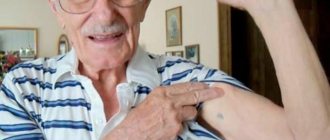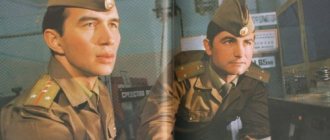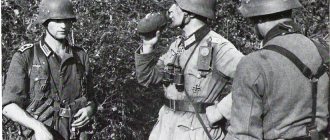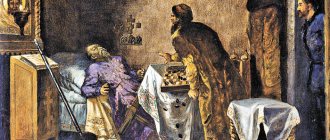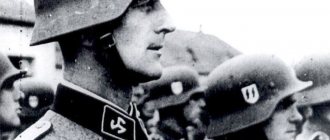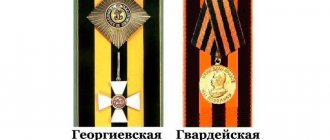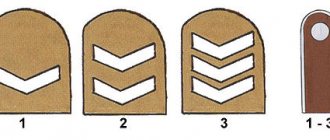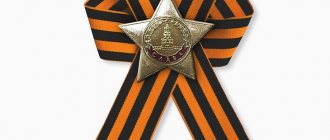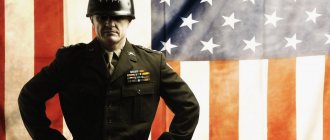Coat of arms of the Third Reich (eagle with swastika)
Already a year after Hitler came to power on February 17, 1934, an order appeared to introduce a new insignia for the Reichswehr, primarily on steel helmets, caps, uniforms and jackets. This sign became an eagle with outstretched wings on a swastika.
The first uniform was a cap with an eagle with outstretched short wings and the head turned to the right, in the eagle's claws there was a swastika in a wreath. This insignia had a width of 4.9 cm and a height of 2.8 cm. In March 1935, a new, elegant uniform was introduced, which remained unchanged until the end of the war. The new sign had a width of 6.3 cm and a height of 2.5 cm. Until 1935, this flat sign was stamped from cupronickel, later from light aluminum. First of all, this sign was introduced on the caps of all branches of the military. In November 1942, it was first prescribed that from January 1, 1943, generals would wear this gold-colored badge on their caps (even on field caps and mountain caps ). Other ranks wore the eagle badge made of aluminum until the end of the war.
Individual representatives of the command could afford the sign of an eagle with a swastika on a handmade cap, embroidered with silver or aluminum threads (generals - gold). It was embroidered on a lining that was initially grey, but from 1935 dark blue-green cloth On November 16, 1942, this freedom for military dandies ended and a ban was introduced on wearing a handmade badge. However, despite this, officers continued to sew and wear such badges.
Cap
The so-called “Be-Vo” insignia was worn on this headdress. This name has taken root among modern collectors. It comes from the abbreviated name of the Ewald Forstecher Sewing Factory, the largest manufacturer of such insignia. For non-commissioned officers and enlisted personnel, the coat of arms of the 3rd Reich was embroidered from silver or mouse-gray cotton thread, respectively. For officers, this badge was made of aluminum-colored threads and hand-embroidered. The cap was worn with an insignia, which was a smaller copy of the eagle insignia described above.
Generals and officers
For this group of command personnel, the coat of arms of the 3rd Reich was used, which underwent the following changes:
from October 1935 to July 1937: badge made by machine embroidery from aluminum thread on a gray base
from July 1937 to June 1943: a badge made of machine embroidery from aluminum thread on a base of dark blue-green color (for generals from January 1, 1943, a badge made of gold threads)
from June 1943: the badge was machine embroidered in aluminum and gold thread together with the black, white and red Reichswehr cockade, it was made separately on a dark blue-green base in a trapezoidal or T-shape.
| Various options for making the coat of arms of the 3rd Reich (2nd form) on caps. The first two are made of aluminum alloy, of which the left one is an earlier version. Middle - stamping from an aluminum alloy of gray (grey) color, used during the war. On the right is a sample embroidered with aluminum thread. Below, samples of oak leaf wreaths and cockades show all three options that were used in 1935. | On January 1, 1943, generals began to wear the coat of arms of the 3rd Reich on their gold-colored headdresses. At the top there is a metal stamping for wearing on a cap and at the bottom - the same hand embroidery |
Non-commissioned officers and enlisted personnel
For this group of military personnel, the coat of arms of the 3rd Reich was used on the cap, which underwent the following changes:
from October 1935 to July 1937: badge made by machine embroidery from white thread on a gray base
July 1937 to June 1940: machine embroidered badge in silver-gray thread on a dark blue-green base
from June 1940 to June 1943: mouse gray insignia on a gray base from June 1943 to 1945: machine embroidery badge made of mouse or light gray thread with a cockade on a gray trapezoidal base or T-shaped (on the cap it is similar to 1942 and on the cap of a military unit).
| Swearing in of recruits of the 9th Infantry Regiment. Potsdam, autumn 1935 | Infantry officer's cap from the Reich Army. The hand-embroidered oak leaf wreath is made of silver gimp. It is made according to the old model adopted in the Reichswehr. A braided cord made of silver thread, its purpose is purely decorative. Gray edging made from insignia fabric. The coat of arms of the 3rd Reich (eagle with swastika) of the first form made of aluminum alloy and cockade were pinned later in 1933 or 1934. | The coat of arms of the 3rd Reich on the cap of an infantry corporal appeared between October 1935 and June 1937. The badge is embroidered with white thread and gray fabric. The cockade is embroidered in the same way, but the fabric is mousy gray. |
Uniform jacket and uniform
In accordance with the order of February 17, 1934, the new insignia - the coat of arms of the 3rd Reich - was located horizontally on the right side of the chest at the level of the second button . Various styles of this sign are known: hand and machine embroidery. metal stamped. They were used according to the rank of the serviceman and part of the uniform. Handmade signs were especially notable for their wide variety of designs.
Generals wore gold-colored badges on their jackets and uniforms; for all other officers, the badge was embroidered from silver or aluminum-colored threads (the latter introduced in September 1935).
In March 1935, a badge of hand embroidery made of silver threads on a gray base was established for the ceremonial jacket, which was replaced with a dark blue-green base in June 1937. This innovation was later transferred from the piping to the jacket and uniform of the corresponding branch of the military.
In the same month, a hand-embroidered insignia made of silver or aluminum thread on a gray cloth base was introduced for the uniform jacket and field uniform (since June 1937, it was replaced by a dark blue-green cloth patch). Many officers wore hand-embroidered insignia on their uniforms, although this was prohibited by the regulations.
For the officer's summer white jacket, a raised stamped aluminum alloy insignia was introduced in November 1937, which was gold plated for generals and silver plated for officers. According to the order of July 15, 1938, generals wore hand-embroidered insignia on their tunic, uniform and field jacket; only for the white tunic it was prescribed to wear stamped metal insignia (however, in reality this rule was not always followed).
| Knight of the Oak Leaves to the Yellow Cross, Oberfeldwebel Joseph Schreiber from the 14th Assault Regiment. On his cap in 1943, the coat of arms of the 3rd Reich and the cockade were sewn onto a trapezoidal piece of gray fabric. | Major of the 61st Infantry Regiment in full dress uniform. On his cap is the coat of arms of the 3rd Reich, first form. | Embroidered samples of the coat of arms of the 3rd Reich on officer caps. On the left are two samples made of aluminum filament based on a dark blue-green color. On the right is a sample made in June 1943. |
Non-commissioned officers and enlisted personnel
The coat of arms of the 3rd Reich was worn as already described in the “Pilot” section. On certain parts of the uniform this insignia could be hand-embroidered as worn by officers, but this was an exception.
Belt fastener (buckle)
From January 1936, a belt buckle for non-commissioned officers and soldiers was introduced, using the Wehrmacht eagle buckle t.s. an eagle with its head turned to the right, with outstretched wings and a swastika without a wreath. The border included two crossed wreaths of oak leaves and the inscription “God is with us” on top. A short time later, in the same 1936, a sample was presented in which the eagle's head was turned to the left.
The same insignia was also on the buckle of the field belt of officers, which was introduced in July 1937. A special part of the officer’s uniform was the dress uniform, which differed from the everyday uniform and work uniform and was worn by special order. The dress uniform belt had its own characteristics. A 4.5 cm wide braided aluminum thread braid bordered two interwoven stripes of a dark blue-green color. The round clasp buckle - brushed aluminum color for officers and gold color for generals - also featured the Wehrmacht eagle, which was however framed by a wreath of oak leaves. On the reverse side of the field belt there was a lining made of gray fabric.
Coats of arms of the 3rd Reich for jackets and uniforms of generals and officers:
| Sample for the general: hand embroidery from a natural silk substitute in gold color. | A badge made by machine embroidery from aluminum thread on a dark blue-green base and sewn onto cloth . | Embroidery of silver capitals on a gray base |
| Metal stamped for a white jacket. This one is made from Melchi Ora. The reverse side of the metal sign. | Hand embroidery from aluminum gimp on a gray base. | |
| A sign made by machine embroidery from aluminum thread on a gray base and sewn onto cloth . | Hand embroidered with aluminum thread on a dark blue-green base. | Made from light gray threads on gray cloth |
| Coat of arms of the 3rd Reich with a cockade on a T-back piece of cloth for the cap of mountain rangers. | Made of white threads on gray cloth. | Made of white threads on black cloth - for jacket . |
| Made from white threads on dark blue-green cloth. | Made from mouse-gray threads on gray cloth for a field uniform, model 1944. | Made from threads of silver-gray color or cloth of dark blue-green color. |
Field uniform
According to the order of November 12, 1934, a special black uniform was introduced for service in tank forces, which consisted of a protective helmet (like a beret), a field jacket and trousers. The embroidered insignia (eagle with swastika) on a black cloth base on the beret and jacket was initially white, then silver-gray cotton thread was used. During the war, mouse gray thread was used. Officers wore an embroidered or handmade insignia of light aluminum color on a black base.
| Made from mouse-gray threads together with a cockade on a trapezoidal piece of cloth for a cap model 1942, n cap . | For servicemen in the active army in the combat area, the insignia on their shoulder straps had to be covered, as required by the order of January 1940. When returning to their homeland, they had to be re-opened. shoulder straps were introduced for soldiers and non-commissioned officers . The removable titles were a cloth ring made from a single piece of gray cloth, 3 cm across and wide enough (5 cm) to fit over a standard Army cloth shoulder strap . Numbers, letters, or combinations thereof were embroidered on these pieces of fabric or sewn to them. Their color corresponded to the color of the branch of the army that wore them. The photo shows a guard with such shoulder straps. The coat of arms of the 3rd Reich for jackets, uniforms and headdresses of non-commissioned officers and soldiers, made by machine embroidery: | This soldier wore an eagle with a swastika on his ceremonial uniform in March 1935, machine embroidered from aluminum thread on gray cloth. This is what officers wore on their everyday uniforms and field uniforms. |
Paired buttonholes with crimson edging on black cloth and the emblem of the armored forces of the Wehrmacht Ground Forces - “death’s head”. High quality copy.
In the Panzerwaffe, the jackets had black buttonholes with pink trim sewn on them; each buttonhole had a skull with crossbones without a lower jaw. This skull is identical to the early SS cockade introduced before the Nazis came to power. The roots of this symbolism of the German army go back to the 19th century: then cockades with a skull were worn by hussars; skulls in the form of cockades were worn during the First World War by some hussar units, whose non-commissioned officers and officers, after the introduction of new caps of the 1935 model, attached a cockade with a skull between the eagle and the “wreath”. In short, the skull was a purely cavalry emblem, and since many tank divisions were reorganized from cavalry ones, it also migrated to the tankers. In addition, during the First World War, flamethrowers wore a patch with a skull on their sleeves. An eagle was sewn on the right side of the chest.
On November 17, 1934, a new uniform was introduced for German tank crews, intended for work on armored vehicles. Heinz Guderian, the creator of the German tank forces and the Blitzkrieg strategy, personally took part in the development of the new uniform. The new uniform was black and, as already mentioned, was intended exclusively for work on armored vehicles, and in all other cases, tankers were ordered to wear the usual Wehrmacht uniform, which differed from the uniform of other branches of the military only in the pink military color and codes on the shoulder straps, as did all other branches troops among themselves. But the stunning successes of the German armored forces in the first years of World War II led to the fact that black uniforms began to be worn by everyone who had even the slightest connection with the tank forces, and the tankers themselves, who became proud as hell of their elegant black uniforms, began to wear them at any time. case, even as a day off and a formal occasion.
The new uniform was specially designed for people who had to climb into, work and fight, and sometimes quickly leave a cramped tank with a lot of protruding parts, oil stains, etc. That is why black was chosen as the color of the uniform to make it as non-marking as possible. The jacket was short, with a large turn-down collar and wide lapels. The left side was widely folded over the right side, in addition, the edge of the left side went obliquely, towards the center line of the body, so the jacket protected well from the drafts that reigned in the tank. The jacket was fastened with 3 or 4 large plastic buttons sewn on the right side. Additionally, two more buttons were sewn onto the edge of the right side, which were fastened to the loops in the lining and kept the side from creeping up or down when the jacket was buttoned. According to the regulations, it was necessary to wear 3 more small black buttons above the lapels: above and below the breast eagle and under the right collar, therefore for these buttons there were loops on the left side of the jacket, the jacket was completely buttoned very rarely and only in cold weather, then it was already buttoned on hook on the collar. To make the jacket more elegant, many tankers tore off the top buttons and never buttoned it completely. Military personnel who sewed uniforms privately did the same; in this case, they did not even sew on the top buttons or make loops on the left lapel.
Technologically, the jacket was made of four parts, connected to each other by thick seams on the sides and on the back. Small vertical folds were made on each such part in order to fit the jacket more tightly to the figure. The seam running along the back of the sleeve split 15 cm from the edge, forming a cuff fastened with a button at the wrist. The cotton lining was sewn only on the front, left and right sides. An internal pocket was made on the left side of the lining; sometimes such a pocket was also made on the right. On the inside of the jacket there was a braid or fabric belt, which further adjusted the jacket to the figure. With the jacket it was necessary to wear a gray or feldgrau shirt with a black tie. Early shirts were made without any additional details; over time, a shirt with patch pockets and loops for attaching shoulder straps appeared. Often such shirts with shoulder straps, a breast eagle and awards were worn in hot weather as outerwear. In cold weather, a high-neck sweater, popular in the Wehrmacht, was worn under the jacket; the color could vary from black to feldgrau, but more often for tankers it was a gray sweater. In the early years of World War II, the only outerwear for tank crews was an ordinary Wehrmacht overcoat, which, as you understand, was not very convenient for working in a tank. And since October 1942, a winter turn-out suit began to be seen more and more often among tank crews (among them, a gray suit was often found, and not a camouflage one, as in the Wehrmacht).
The trousers were made from the same black fabric as the jacket. They had a straight, loose fit and tapered only at the ankles, where there was a small slit with a button and ribbon to tighten them. The trousers had a sewn-in fabric belt, although there were trousers without a belt, but with loops for threading a regular belt. On the sides of the trousers there were two slanting welt pockets with flaps, each of which was fastened with a button or button. There was a small pocket on the front right for a watch. At the back there were two horizontal pockets with flaps, which were also fastened with a button or button. Trousers were usually worn over standard marching boots, although sometimes, very rarely, tankers tucked their trousers into their boots. In 1941, boots with gaiters were introduced to replace boots for wear in tank units, but those who had previously received boots continued to wear them until the last day. Gaiters were practically not worn, since even without them the trousers were perfectly tightened at the ankles.
At first, the only headdress to be worn with a black uniform was a black beret. It was made quite loose and was worn over an inner cap made of felt and oilcloth. But this headdress was not popular among tank crews, firstly, simply because it was impossible to wear standard tank headphones with a beret. Most tank crews preferred to wear ordinary feldgrau-colored caps with a pink corner (the military color of tank crews) as headdress. Even during the Polish campaign, black caps appeared, which were made privately by tank crews and were similar in cut to standard Wehrmacht caps. By order of March 27, 1940, the wearing of a beret was abolished and a black cap was officially introduced as the only headdress for a black uniform. As already mentioned, such a cap was similar in cut to the general military cap, but was made of black fabric, the imperial eagle and a three-color cockade were embroidered on black linings, and on the cap, above the tricolor cockade, there was a military-colored corner worn. On officer caps, a silver flagellum was sewn along the edge of the bottom and the cutout of the lapel. The new cap became widespread among tank crews and by 1941 had practically replaced the unpopular beret.
In 1943, the field cap was introduced throughout the Wehrmacht as a single headdress, and tank crews were not spared this order. The tankers' cap did not differ in cut from the general-arms cap, but was made of black fabric, the eagle and cockade were embroidered on a black trapezoidal flap, and on the officer's cap a silver flagellum was sewn along the seam of the crown. Although the cap was very popular among tank crews, it could not supplant the cap, which they continued to wear until the last day of the war. It was quite common practice among officers to wear a standard Wehrmacht cap (with pink edging) and an “old-style” cap with a black uniform. I would like to draw your attention to the fact that during the entire existence of the German tank forces, no special headgear was introduced to be worn in a tank; tank crews made do with caps, caps, and caps, which, as you understand, did little to protect the head. Ordinary helmets were also used, but they were not popular, since standard tank headphones could not be worn under them (in 1944, new, compact headphones were introduced that could be worn under a helmet, but they did not save the situation).
The insignia for the black uniform was a rather unique phenomenon and nothing special, but this was not the case in the German army. On the right side of the chest, all military personnel, regardless of rank, wore an imperial eagle embroidered on a black lining. For privates and non-commissioned officers, the eagle was embroidered with white thread (after 1942, light gray), while the officer's eagle was in most cases embroidered with thick aluminum thread. The edge of the collar of the black jacket of all military personnel, from private to general, was trimmed with military-colored piping (pink for tankers). At the corners of the collar they wore black rectangular buttonholes, which were edged with military colors; in the middle of the buttonholes, a silver-plated (oxidized silver) metal emblem of the tank forces, the “death’s head,” was attached. The sleeve insignia of privates and corporals were similar to the general arms insignia, but were embroidered on black fabric flaps. The shoulder straps of privates and non-commissioned officers, unlike the general-arms ones, had a black field, but otherwise they were no different from them. The officers' shoulder straps were completely similar to those of the combined arms.
In addition to the tankers themselves, the crews of armored vehicles, armored personnel carriers and armored trains received black uniforms. Their uniform differed from the tank crew uniform in that instead of pink, the edges of the collar, buttonholes, shoulder straps, the colored corner on the cap, and the piping on the cap were trimmed with the military color of the corresponding unit.
Armored reconnaissance units formed before September 1939 on the basis of cavalry units received a golden-yellow military color as a military color, while all newly formed reconnaissance units received a copper-yellow military color, military personnel of all reconnaissance units wore an encryption on their shoulder straps - the letter “A” " The crews of the armored communication vehicles had the traditional lemon-yellow military color. In March 1943, new military colors were introduced for some units. Reconnaissance units, instead of copper-yellow, received pink military color, like the tank crews, but continued to wear the letter “A” on their shoulder straps. Units that traced their history back to cavalry units retained the traditional golden yellow color. The personnel of the armored trains also received pink military color with the letter “E” on their shoulder straps.
According to the regulations, the black uniform of generals of tank units differed from the uniform of privates and officers by a metal golden breast eagle, general's golden-white shoulder straps and gold piping and an eagle on a black cap. But often, generals decorated their uniforms a little to emphasize their dignity as a general. For example, often, and even almost always, generals wore general general's buttonholes instead of the required death's head buttonholes. There is a known uniform where the collar is edged not with pink, but with golden edging. Black trousers with stripes were not worn with a black uniform; trousers were without stripes.
After all of the above, it should only be added that in 1942 the wearing of pink piping along the edge of the collar was abolished, but those who had previously received a jacket with piping and those who made uniforms privately continued to wear piping along the edge of the collar until the end of the war. In the same year, the wearing of a military-colored corner on a cap was abolished. And yet, from the middle of 1944, tank crews were no longer issued general-arms uniforms in feldgrau color, and after that, tank crews officially began to wear black uniforms, even as a day off and dress uniform, although even then there was no time for parades.
Military rank insignia
In the German army, military ranks were worn on officer shoulder straps or on non-commissioned officer shoulder straps. The exception was the military ranks of enlisted personnel, which were worn on the left sleeve of the uniform, jacket and overcoat.
A) Rank and file
The insignia for a soldier and a senior soldier differed by category and branch of the army: riflemen, motorized infantry, grenadiers, panzergrenadiers or private motorized infantry, gunner or panzercanonier of artillery, cavalry cavalryman. sapper or panzersapper of engineering troops, private of jäger or mountain rifle units, private of tank troops, etc. Accordingly, the insignia of chief soldier was achieved by adding the word chief. for example, chief rifleman or panzerbergrenadier, etc.
Sewn shoulder straps were made of dark blue-green cloth and had a cloth edging in the color corresponding to the branch of the military (see Table 1). Shoulder straps were the same for all ranks of enlisted personnel from soldier to staff corporal. The corresponding insignia was worn on the left sleeve. The lining for this insignia was made of gray cloth (1933-1935), or dark blue-green (1935-1940), or gray (since 1940).
Since October 1936, the chief rifleman had his own insignia - a square star made of silver-gray thread or artificial matte gray silk (since 1940) on a round piece of cloth, made by machine. Corporal , Corporal Corporal, etc. They also wore, from October 1936 a chevron made of silver braid sewn to an equilateral triangle cut out of dark green cloth.
Promotion to chief corporal, orderly to chief corporal, etc. usually followed after 2 years; for the appropriate case, an insignia in the form of a second, smaller chevron was added. After 6 years of service, the insignia was replaced by a double chevron , between the sides of the corner there was a silver metal star of the same style as for the chief soldier, made by machine.
The highest military rank for enlisted personnel was staff corporal. He wore the insignia of a double chevron with a silver metal star inside the corner. However, promotion to the rank of chief corporal began to be discussed for the first time since April 1942 - after an 8-year break.
| 1. Officer's shoulder straps of the chief lieutenant of the 537th communications regiment of the army group. Flat holes are made of matte aluminum threads. 2. Officer yoga for the captain of the 10th Cavalry Regiment. Flat holes are made of light aluminum threads. 3. Sewn shoulder strap of the staff sergeant major of the 30th anti-tank division. | Sergeant major of the 24th anti-tank division. He wore the pointed shoulder strap of Form 1, which was introduced in 1933 for the field uniform. | On the left is the shoulder strap of a reserve non-commissioned officer of the XII Military District. The upper part is made of dark blue-green cloth. On the right is the shoulder strap of a sergeant major of the 11th Infantry Regiment. Here the upper part is made of dark gray cloth. |
B) Non-commissioned officers
Within this group, military ranks were divided into 2 classes. These were the so-called non-commissioned officers without sword belts and warrant officers. as well as non-commissioned officers and non-commissioned sergeants, or sergeants. A sword belt - a special type of lanyard with silver threads braided around the stem and rim of the hand - distinguished the sergeant major, having a heraldic rather than utilitarian meaning. The common badge for all non-commissioned officers consisted of a stripe (galloon) or trimmed edging on the collar of the jacket and uniform. and also on the cuff of a military uniform. Initially, the insignia was recognized on the shoulder strap, which also had stripes and edging. A white metal star was on the shoulder strap of a non-commissioned officer without sword belts (next to the insignia of the branch of service).
Non-commissioned officers and enlisted personnel used two different types of shoulder straps :
shoulder strap of form No. 1 had a triangular top, without edging and had a removable fastening. It first appeared on tunics in the spring of 1933 and was first gray in color, and from September 1935 it began to be made from dark blue-green fabric
The shoulder strap of uniform No. 2, on the contrary, had an edging along the top and the color of the branch of service. It was worn on a military uniform, on an overcoat and, from November 1938, on a uniform. Since 1940 it has been made of gray fabric. On the uniform and tunic it was sewn on and had a rounded shape; in other cases it was attached to a loop.
S-1) company officers These officers also had two types of shoulder straps . The first was worn by chief lieutenants and lieutenants, the second by captains and captains.
Both of them wore shoulder straps made of paired flat cords woven from aluminum-colored thread. The base of the shoulder strap had a color corresponding to the type of military service. On the shoulder straps of the chief lieutenant and captain there were stars made of gold-colored metal (one and two, respectively), as well as insignia of the military branches and insignia of service (belonging to the corresponding unit or unit).
S-2) Staff officers (senior officers) This composition of military ranks included: major ( major of medical service, etc.), lieutenant colonel ( lieutenant general of medical service, etc.) and colonel (general of medical service and etc.). They wore braided shoulder straps made of two paired flat cords woven from aluminum-colored thread on a lining in the color of the corresponding branch of the military. The stars, as well as the insignia of the military branches and the insignia of the corresponding unit or unit, were also made of gold-colored metal.
The shoulder straps were sewn to the corresponding parts of the uniform. On everyday and field uniforms, matte colored cords were used, on other types of clothing, on the contrary, shiny ones. Stars and insignia on shoulder straps during wartime were made of gray aluminum alloy with a gold-colored coating, which, however, was easily erased.
S-3) Generals
Military ranks of this class cover 5 categories: major general ( major general of the medical service, etc.), lieutenant general ( lieutenant general of the medical service, etc.), general of the infantry (cavalry, artillery, engineering troops, tank troops, signal troops and mountain rifle troops), colonel general and, finally, field marshal general. shoulder straps were also woven, but from a triple cord, while the outer cords were made of gold-colored thread, and the inner cords were made of silver or aluminum-colored thread (on the field uniform, they were made of matte-colored gold and aluminum cords). The stars, as well as the insignia of the corresponding unit or unit, were silver or aluminum in color; the lining material was usually scarlet (bright red).
Initially, shoulder straps were made of two gold-plated cords and one medium cord of silver or aluminum thread. By order of April 3, 1941, it was established that the weaving will henceforth consist of three gold-plated braided cords, of which the inner one will have an edging. shoulder straps were also used .
The field marshal's shoulder straps had crossed marshal's batons made of silver or aluminum as a sign of the highest military rank. There were two examples of these shoulder straps : an early diamond-shaped one and a smaller example introduced in September 1940, which carried a patterned marshal's baton.
| 1. Chief sergeant major of the 3rd battalion of the 78th infantry regiment. 2. staff sergeant major ( 1st uniform shoulder strap lieutenant (here: reserve officer) 4. chief lieutenant of the 13th anti-tank division 5. captain of the 60th artillery regiment | 1. Rifleman, chief rifleman, corporal , chief corporal, etc.). (infantry) 2. non-commissioned officer (personnel of the army non-commissioned officer school of the IV military district). 3. non-commissioned sergeant (mountain rangers) 4. sergeant of the 8th cavalry rifle regiment, February 1940. |
| 1. lieutenant general (wartime matte shoulder strap) 2. general of infantry, artillery, etc. 3. Colonel General 4. Field Marshal General (on the right is the example used since 1943) | 1. Major of the 10th Cavalry Regiment 2. Chief Lieutenant of the 39th Infantry Regiment 3. Colonel of the Medical Service 4. Major General |
Insignia of military branches and service
On shoulder straps and sleeve patches, along with the color of the military branch and military rank, there could be signs indicating numbers. letters and symbols. These were insignia of the military branches and affiliation with a certain unit or unit, the latter were only worn by officers. Privates and non-commissioned officers without sword belts had these signs directly embroidered on their shoulder straps with the corresponding color of the branch of service. Non-commissioned officers with sword belts and officers had the same insignia on their shoulder straps. stamped from white or gold metal.
A) Numbers
They were made in the form of Arabic or Roman numerals. The first of the two denoted a military unit of a particular type of army, the second indicated the corresponding military district or army corps.
B) Letters
For this, both Gothic and Latin letters were used. In this case, combinations of three letters placed together or combinations of letters, Arabic or Roman numerals could be used.
C) Symbols
They could indicate affiliation with a particular service (for example, medical service or military police ), a branch of the military (for example, army anti-aircraft units), or military units with special symbols (for example, the 271st Infantry Regiment "hall of commanders" or 5 1st Cavalry Regiment).
Table 1. Troop colors (1939 model) | |
| Color Rod | Type of army |
| scarlet | artillery, medical and veterinary officers |
| carmine | General Staff, military officers of the OKW and OKH, veterinarians |
| white | infantry |
| black | engineering troops |
| pink | tank forces |
| burgundy | chemical smoke troops |
| light green | Jaeger battalions and regiments, mountain rifle regiments |
| dark green | military officials |
| golden yellow | cavalry |
| lemon yellow | Signal Corps |
| cornflower blue | medical service troops |
| orange-red | firefighters (until October 1939). field gendarmerie (after October 1939) |
| violet | military chaplains |
| light gray | army propagandists |
Buttonholes
Oblique rectangular linings made of cloth fastened to the collar were marked as buttonholes . At the same time, the following models differed: buttonholes with special embroidery for generals, buttonholes with the so-called “cob” embroidery, buttonholes with a double braided cord (galloon) and special buttonholes on black or gray overalls.
Buttonholes with special embroidery for generals
Generals wore special embroidery made of gilded thread on their buttonholes made of bright red (scarlet) lining (in wartime it was replaced by embroidery made of gilded celleon, a substitute for natural silk). This ersatz embroidery was called “Larish embroidery” after the Prussian general who introduced it in 1900. It had a double stem in the center with leaves pointing up and down, and a tail bent down behind it.
For the Field Marshal, embroidery of the same type was introduced in April 1941. but with a triple stem, so that its buttonholes were a little longer. Some army field marshals continued to wear the old buttonholes . These were those who did not have time to receive signs of promotion. For example. Friedrich Paulus, who was awarded the rank of field marshal by Hitler the day before the surrender at Stalingrad. Another example is Ferdinand Schörner, who was awarded this title in the last month of the war. The opposite case. when promotion signs managed to find their owner - this is the example of Major General Heinrich Kreine, who was kidnapped in 1944 by British commandos in Crete. By that time, his uniform already had field marshal buttonholes.
buttonholes reflecting these features were introduced for generals serving in special forces For example, cornflower blue buttonholes for medical service officers or bright red (carmine) buttonholes for veterinary service officers.
| 1. Double buttonhole with shiny braid on a dark blue-green base (sample 1933). 2. An early version of the buttonhole with middle dock stripes in a dark blue-green color (sample 1938). 3. Double buttonhole based on the color of the military branch - infantry (sample 1927). | 1. Buttonhole with middle and side stripes of dark blue-green color (pre-1938 example). 2. Double buttonhole made of light aluminum thread based on the color of the military branch - cavalry (sample before 1935). 3. Buttonhole with middle and dock stripes in gray (sample 1940). | A newly minted holder of the Knight's Cross with the sleeve badge of the Jaeger units. Three recently received stripes for destroyed tanks are sewn onto the top of the sleeve. |
Embroidery "cob"
Even in the Weimar Republic, senior officers and captains of the Reichswehr Ministry and the Weapons and Supply Inspectorate wore bright red (carmine) buttonholes with golden-matte “cob” embroidery. Senior officers and captains of the General Staff wore the same embroidery on their buttonholes, but in a matte silver color. Since 1927, light gold or light silver embroidery was introduced on the buttonhole of the ceremonial jacket.
The Wehrmacht adopted this embroidery for officers of the high command and ground forces (light gold embroidery on carmine buttonholes), for officers of the general staff (light aluminum embroidery on carmine buttonholes) and for music inspectors and leaders (light gold embroidery on scarlet buttonholes). colors). The uniform had the same matte alominium or matte gold embroidery on the buttonholes made of dark blue-green fabric.
These special badges were, however, abolished at the end of 1942 and the officers of these military units were henceforth to wear the same buttonholes that were worn by the rest of the “mere mortals” - their fellow officers. In some cases, buttonholes with “cob” embroidery were worn even before the end of the war.
Double buttonholes or musicians buttonholes
Double buttonholes on the collar were introduced back in 1809 by the Prussian king Frederick William III specifically for the guards regiments. In 1919 it became a common insignia of the Reichswehr, a common property of the German army. The double buttonhole was often sewn directly onto the collar.
Officers
Here two different samples were used, borrowed from the Reichswehr:
1932 pattern: embroidered matte silver double buttonhole on gray cloth collar. In the middle of each buttonhole there was a long narrow stripe in the color of the branch of service. In the Reichswehr army it was worn on a tunic, in the Wehrmacht - on service and field uniforms. Instead of silver thread, from September 1935 the buttonhole was to use aluminum thread and a dark blue-green cloth collar. During the war, a double machine embroidered buttonhole made of light gray or gray thread was used. The last change came in the fall of 1944 when matte gray buttonholes began to be embroidered along with a velvet collar.
Sample 1927: light silver embroidered buttonholes were introduced on the ceremonial tunic, which covered the entire surface of the buttonhole . This double buttonhole was sewn directly onto the collar in the color corresponding to the branch of the military. In the Wehrmacht, these buttonholes were worn on the uniform uniform, dress uniform and uniform with piping. Since September 1935, light aluminum thread has been used to embroider the buttonhole.
Private and non-commissioned officers
There were also various samples here.
1920 Pattern: This year saw the introduction of gray embroidered double buttonholes , which were the same for all military personnel from trooper to colonel. They were sewn onto a gray cloth collar.
Model 1927: on uniforms they wore silver embroidered double buttonholes on cloth in the color of the corresponding branch of the military.
Sample 1933: for field and service uniforms, embroidered double gray buttonholes made of cloth in the color of the corresponding branch of service were introduced. buttonholes made of gray cloth were replaced with dark blue-green cloth
Sample 1935: On a military uniform they wore an embroidered double buttonhole made of light aluminum thread, which was on buttonholes made of cloth in the color of the corresponding branch of the military.
Model 1938: the so-called single gray buttonhole was worn on the uniform; its surface was the same for all branches of the military and was made of dark blue-green cloth. Between the two braids was a stripe of dark blue-green color. Since 1940, a single buttonhole on field and service uniforms has been sewn directly onto the collar in the usual way.
Model 1940: as before, but the buttonholes are mouse gray and the surface between the braids is gray.
| 1. Double machine-embroidered buttonhole in matte aluminum color based on dark blue-green color (artilleryman's field jacket ) 2. Double hand-embroidered buttonhole in light aluminum color based on the color of the branch of service (here: on a cavalryman's dress jacket). 3. Double buttonhole embroidered from light gray thread on a dark blue-green base. | 1. Double buttonhole embroidered from matte silver thread on a gray base. Reichswehr. 2. Double buttonhole with special embroidery (cob embroidery) made of thread entwined with silk of matte aluminum color. For officers of the General Staff. | 1. Light gold embroidery for field marshals (from April 1941) and generals 2. Double hand embroidered buttonhole in matt aluminum color on a dark blue-green base (cavalry field jacket ). 3. Double hand-embroidered buttonhole in light silver color based on the color of the military branch (here: artillery). |
Buttonholes on a black or gray jacket
jacket was introduced for tank troops in November 1934 as part of special uniforms. She had a rectangular black buttonhole on which was pinned the Prussian Death's Head symbol. The following colors for tank units were established for it:
- tank and anti-tank forces: pink
- scouts: golden yellow or pink
- 24th Tank Regiment: golden yellow (from April 1941)
- Corps of Engineers: black until May 1940, then black and white
- Signal troops: lemon yellow.
Since May 1940, the same special uniform, but in gray color, was introduced for the artillery of self-propelled gun units (Sturmgeschütz). On the jacket - after a year and in this entire branch of the military - there are various buttonholes that cause confusion. These were black and gray “dead heads” on the collars using a single, double (for handmade officers) buttonhole and collar; the edging of the buttonholes, depending on the unit, could be of different colors: scarlet, pink, grass green, white, lemon yellow or golden yellow.
| chief corporal; chief corporal with more than 6 years of service; staff corporal | Badges that were worn on the left sleeve in the area of the shoulder of the uniform, jacket and overcoat: chief shooter; corporal _ |
| Buttonholes with the Death's Head emblem for a black (left) and gray (right) field jacket . | Captain, holder of the Knight's Cross Alfred Tsimap from the 93rd heavy anti-tank division with a non-commissioned officer of his unit. He wore gray tabs with the Death's Head emblem on his self-propelled field jacket. |
The highest award of the Wehrmacht
Knights of the Iron Cross 2nd class often wore only one ribbon instead, consisting of a red stripe bordered by white and black stripes. Traditional colors of the Third Reich.
The same tape
Why did the military wear only one ribbon? It was all about conservatism and tribute to tradition. The Iron Cross appeared during the Napoleonic Wars during the reign of William III.
In those days, the award itself was worn only on a number of occasions. Firstly, it was worn immediately after presentation, and was worn only for one day. Secondly, such awards were left on the dress uniform and were not taken with them on field trips.
It is noteworthy that the Crosses that were issued during the First World War were different from the new ones. They had a different date on them, and the crown was replaced with a swastika.
In the Third Reich, the Iron Cross had as many as 9 different versions. The Knight's Cross with diamonds, oak leaves and swords, in gold, was considered the “best”. Only Hans-Ulrich Rudel, the famous Luftwaffe ace, had such an award.
Hans-Ulrich Rudel
